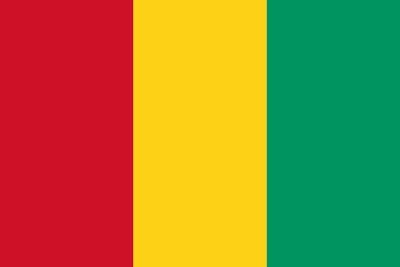This Week In Vexillology #260
It's a special Friday edition of This Week In Vexillology and we're heading back into the Lost Archives of the Unfortunate Wordpress Experiment to take a look once more at the flags of the two Guineas: Guinea and Guinea-Bissau.
First up, we've got Guinea:
Adopted on November 10th, 1958 for national and civil usage Guinea followed Ghana (and I guess Ethiopia's lead) in using the pan-African colors of red, yellow and green. The flag is modeled on the French Tricolor (since Guinea was a French Colony) and the colors are also taken from the RDA, the Rassemblement Democratique Africain, which was the dominant political movement at the time of independence. (Apparently Sekour Toure, the first President of Guinea was a close associate of Kwame Nkrumah, the first President of Ghana who's flag is remarkably similar to Guinea's.)
The color scheme is pretty simple: red symbolizes the sacrifice of the people, the yellow is for the sun and the riches of the earth and green is the country's vegetation. (The flag's wiki-page says red stands for the blood of martyrs who died from slavery and wars, so that's one alternate explanation.) If you think it looks pretty similar to a few other flags out there you're not wrong: reverse the colors (green-yellow-red) and you've got the flag of Mali. Add an 'R' and you've got the pre-2001 flag of Rwanda.
Next up, we've got Guinea-Bissau:
Right off the bat we've got an interesting little wrinkle: my reference book says that the flag was adopted for national and civil usage on September 24th, 1973 when the Portuguese territory achieved self-government. The flag's wiki-page dates the adopted from independence which was declared in 1974.
The pan-African colors are evident as is the influence of Ghana. Guinea-Bissau went a little further than it's next door neighbor and brought the black star along for the ride for it's flag. The colors (because apparently every country's independence movement used the same damn ones) are also taken from the flag of the Partido Africano para a Independencia da Guine e Cabo Verde (PAIGC) which is still a dominant party in the country today. (Weirdly: the flag of Cape Verde looks nothing like this. Which is kind of refreshing, really.)
The color scheme is once again, pretty simple: red is for the blood of martyrs/blood shed during the struggle for independence, green represents hope and the forests of the country and yellow stands for mineral wealth and the sun.
And those are the flags of Guinea and Guinea-Bissau! Remember, until next time, keep your flags flying- FREAK or otherwise!
First up, we've got Guinea:
Adopted on November 10th, 1958 for national and civil usage Guinea followed Ghana (and I guess Ethiopia's lead) in using the pan-African colors of red, yellow and green. The flag is modeled on the French Tricolor (since Guinea was a French Colony) and the colors are also taken from the RDA, the Rassemblement Democratique Africain, which was the dominant political movement at the time of independence. (Apparently Sekour Toure, the first President of Guinea was a close associate of Kwame Nkrumah, the first President of Ghana who's flag is remarkably similar to Guinea's.)
The color scheme is pretty simple: red symbolizes the sacrifice of the people, the yellow is for the sun and the riches of the earth and green is the country's vegetation. (The flag's wiki-page says red stands for the blood of martyrs who died from slavery and wars, so that's one alternate explanation.) If you think it looks pretty similar to a few other flags out there you're not wrong: reverse the colors (green-yellow-red) and you've got the flag of Mali. Add an 'R' and you've got the pre-2001 flag of Rwanda.
Next up, we've got Guinea-Bissau:
Right off the bat we've got an interesting little wrinkle: my reference book says that the flag was adopted for national and civil usage on September 24th, 1973 when the Portuguese territory achieved self-government. The flag's wiki-page dates the adopted from independence which was declared in 1974.
The pan-African colors are evident as is the influence of Ghana. Guinea-Bissau went a little further than it's next door neighbor and brought the black star along for the ride for it's flag. The colors (because apparently every country's independence movement used the same damn ones) are also taken from the flag of the Partido Africano para a Independencia da Guine e Cabo Verde (PAIGC) which is still a dominant party in the country today. (Weirdly: the flag of Cape Verde looks nothing like this. Which is kind of refreshing, really.)
The color scheme is once again, pretty simple: red is for the blood of martyrs/blood shed during the struggle for independence, green represents hope and the forests of the country and yellow stands for mineral wealth and the sun.
And those are the flags of Guinea and Guinea-Bissau! Remember, until next time, keep your flags flying- FREAK or otherwise!




Comments
Post a Comment